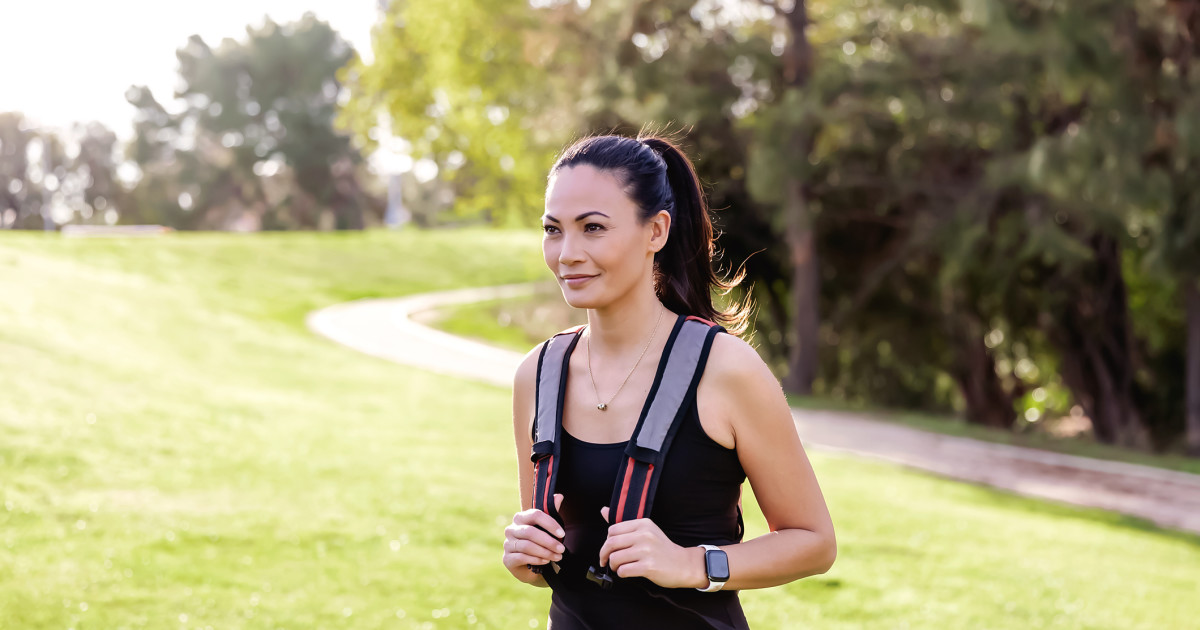
You might have noticed people sporting a new accessory at the gym. No, not an Oura ring or the latest smartwatch. It’s weighted vests.
A weighted vest is a vest worn over the torso. They come in different weights depending on what you buy, but the point is for the vest to serve as a form of resistance training. Simply put, it makes everything you do during a workout more difficult. This is because the added weight makes the heart and muscles work harder.
Some of the benefits of wearing a weighted vest during a walk, run or workout include increasing bone density, improving overall strength and burning more calories. But according to personal trainers we talked to, wearing a weighted vest can work against you too. Here, they explain a surprising downside to weighted vests and give tips on how to avoid it.
🩺SIGN UP for tips to stay healthy & fit with the top moves, clean eats, health trends & more delivered right to your inbox twice a week💊
Working Out With Weighted Vests
Mariana Santos, CPT, a certified personal trainer and the owner of Brazily Fitness, says that weighted vests can be a great fitness tool for some people. “Weighted vests are great for people who already have a solid fitness base and want to build strength, joint stability and endurance—especially through low-impact activities like walking or bodyweight exercises,” she explains.
Kat Pasle-Green, CPT, a certified personal trainer at The Bay Clubs, also says that weighted vests are beneficial for people who regularly work out and are ready to increase the load for physical activities they already perform well.
But both trainers warn against using a weighted vest if you’re new to working out or haven’t worked out in a while. And if you are pregnant, have any neck or back issues or arthritis, they say to steer clear of weighted vests completely.
Related: Research Shows That People Who Do Strength Training Exercises Live Longer—Start With These 10 Easy Workouts
The Surprising Downside To Weighted Vests
Both trainers say that one surprising downside to weighted vests is that they can negatively impact posture. “A weighted vest can cause poor posture if the load is too heavy or incorrectly distributed for the wearer’s body and movement patterns,” Pasle-Green says.
Santos adds that wearing a weighted vest that doesn’t fit properly can also lead to poor posture. Both cases can lead to arching the back or positioning the head too far forward as a way to compensate for the added weight.
Santos says that another downside to weighted vests is that they can put too much pressure on joints, leading to joint pain. She explains that knee, hip and shoulder joints are especially susceptible to this, and that wearing a weighted vest could lead to muscle imbalances. “Imbalances can happen if you repeatedly stress the same muscles,” she adds.
Related: Peloton Trainers Say You’re Probably Overlooking This Simple Workout Tip
How To Avoid These Pitfalls
If you do want to start using a weighted vest, Pasle-Green recommends first consulting a qualified fitness or medical professional who can help you figure out the right weight amount for your vest, based on your current abilities and goals.
Santos recommends starting light (with a vest between 5 and 10% of your body weight and increasing the weight gradually). “Wearing a vest that’s too heavy can strain joints, compromise posture and increase injury risk. The goal is to challenge your body safely,” she says.
Related: The 10-Minute Daily Workout That Rivals Hours at the Gym, According to Trainers
Both experts stress that it’s important that your weighted vest fits correctly. “Choose a snug vest and focus on engaging your core during all movements,” Santos instructs.
When your weighted vest is the right weight for your body and fits correctly, both experts say the risk of experiencing muscle imbalances, joint pain and improper posture can be avoided. Pasle-Green adds that it can be beneficial to work out with a personal trainer the first few times you’re wearing a weighted vest during exercise so they can spot-check for any mistakes you may be making without even realizing it, such as not maintaining proper posture or form.
To avoid any muscle imbalances, Santos recommends mixing movement patterns and targeting all muscle groups. This, she says, helps maintain balance and ensures that a muscle doesn’t get overworked or, conversely, neglected.
Remember, weighted vests aren’t recommended for people who are new to working out. Even if you work out regularly, it’s worth it to meet with a personal trainer before using a weighted vest to ensure you’re using it correctly and maintaining proper form. When used correctly, a weighted vest can add extra benefits to your workout. But safety always comes first.
Up Next:
Sources